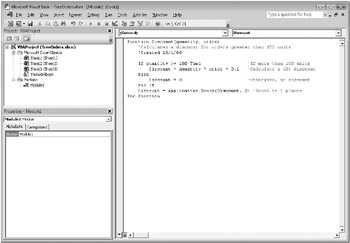Documenting Macros and Custom Functions
Even simple macros and custom functions can be difficult to read. You can make them easier to understand by typing explanatory text in the form of comments. You add comments by preceding the explanatory text with an apostrophe. For example, Figure 27-4 shows the DISCOUNT function with comments. Adding comments like these makes it easier for you or others to maintain your VBA code as time passes. If you need to make a change to the code in the future, you'll have an easier time understanding what you did originally.

Figure 27-4: The DISCOUNT custom function now includes comments.
An apostrophe tells Excel to ignore everything to the right on the same line, so you can create comments either on lines by themselves or on the right side of lines containing VBA code. You might begin a relatively long block of code with a comment that explains its overall purpose and then use inline comments to document individual statements.
Another way to document your macros and custom functions is to give them descriptive names. For example, rather than name a macro Labels, you could name it Month-Labels to describe more specifically the purpose the macro serves. Using descriptive names for macros and custom functions is especially helpful when you've created many procedures, particularly if you create procedures that have similar but not identical purposes.
How you document your macros and custom functions is a matter of personal preference. What's important is to adopt some method of documentation and use it consistently.
EAN: 2147483647
Pages: 260